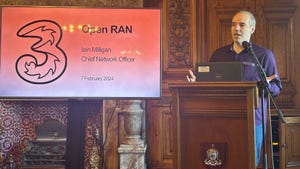Wireless group raises new BEAD concerns
In a letter to the NTIA, the Wireless Internet Service Providers Association (WISPA) said state BEAD plans show that an 'over-reliance' on fiber may exhaust broadband infrastructure funds before everyone is connected.

The Wireless Internet Service Providers Association (WISPA) this week sent a letter to the NTIA raising concerns that multiple states will fail to reach all unserved locations by funding fiber over other technologies.
The concern comes as the NTIA is working on approving initial proposals for how each state and territory will conduct its Broadband Equity Access and Deployment (BEAD) grant program. As WISPA raises in its letter to the NTIA Assistant Secretary Alan Davidson, several states have indicated in those proposals that "a planned over-reliance on funding fiber infrastructure is likely to exhaust BEAD funds before all unserved and underserved locations are connected."
Among the states of concern, WISPA references proposals from Maryland, California, Minnesota, New York and North Carolina that suggest their allotted BEAD funds may not be able to cover 100% of their unserved and/or underserved locations with fiber.
According to Maryland's proposal, for example, the state's share of BEAD funds ($268 million) "can provide for fiber-to-the-premises to the vast majority of unserved locations in Maryland and potentially to most of the underserved locations."
And in California, which is getting $1.8 billion from BEAD, the state's proposal says that if BEAD funds are insufficient, the state will "prioritize projects to serve unserved and underserved locations located in high-poverty and persistent poverty counties" and tribal areas.
As WISPA's letter points out, over a dozen other states indicate they may have enough BEAD funding to reach all unserved and underserved locations with fiber but will not have additional funds for digital equity projects.
"WISPA is greatly concerned that several [proposals] are significantly misaligned with Congressional objectives and BEAD program guidelines in ways that will undermine these states' abilities to successfully reach 100 percent of all unserved locations and meet non-deployment objectives such as digital equity," said WISPA CEO David Zumwalt in a letter to NTIA's Davidson.
"The lack of sufficient BEAD funding these states have identified can be addressed by policy proposals provided by the NTIA for just such a concern: a commitment to setting an appropriately low Extremely High Cost Per Location Threshold and a commitment to deploying appropriate Fixed Wireless Access ('FWA') or other alternative technology solutions that can offer deployment cost savings without sacrificing speed or reliability," Zumwalt added.
The "extremely high-cost per location threshold" (EHCT) is the amount that each state and territory must set at which it's too expensive to deploy fiber-to-the-premises, according to BEAD rules set by the NTIA.
WISPA – which has been raising concerns about BEAD's fiber focus for nearly two years – does not suggest a specific EHCT number, but a spokesperson told Light Reading the organization prefers "the lowest threshold possible ... one which ensures that all – not almost all – can get online with the dollars provided by BEAD."
The trade group, which represents fixed wireless companies, is also promoting a broadband funding dashboard it commissioned from the Vernonburg Group which "demonstrates on a state-by-state basis that an appropriate mix of fiber and alternative broadband deployment technologies can ensure that every state not only connects all unserved and underserved locations, but also has meaningful funds remaining for non-deployment activities," according to Zumwalt's letter to the NTIA.
In addition to concerns from WISPA, another trade group – ACA Connects, which represents small and independent cable providers – released data last week showing that 6.4 million unserved and underserved locations are expected to be eligible for BEAD funding, for which there are enough funds to connect "at least 71 percent of eligible locations" with fiber.
Taking the aforementioned state of Maryland, for example, ACA Connects' framework shows that a "baseline" fiber deployment in that state would reach 60% of locations with fiber and 40% with "other tech," leaving $104 million in "additional funds for affordability programs." Whereas "maximizing" fiber "exhausts Maryland's funds without leaving additional funds for affordability programs," while still only reaching 86% with fiber, according to that group's projections.
When they go low...
While WISPA is pushing for states to set a "low" EHCT, the Fiber Broadband Association (FBA) has been advocating for the opposite.
That organization, in partnership with NTCA–The Rural Broadband Association, released an updated playbook for state broadband offices last year offering guidance on determining the "highest point" at which the threshold can be set while still serving all unserved areas. The playbook points out that the costs of non-fiber deployments will add up over time.
"The EHCT should be set as high as possible," reads the playbook, adding: "...if an Eligible Entity does not maximize fiber deployments, it will almost certainly need to eventually invest in more robust and capable networks yet again later."
Notably, the one state that has had its BEAD initial proposals approved by the NTIA – Louisiana – declined to set an extremely high-cost threshold in its initial BEAD proposal, saying it will "instead will only submit an EHCT value as part of the Final Proposal," once subgrantees are selected.
"In other words, there is no per-location funding level that ConnectLA could not 'afford' to fund in theory at the outset of the process; instead ConnectLA's EHCT focus is on the risk that the actual applications received may not be fully resolvable to deliver either FTTH or some other reliable broadband service to all eligible locations," reads the state's BEAD plan.
It adds: "By declining to establish an up-front EHCT value, ConnectLA is therefore communicating that the state seeks active participation from all types of broadband providers and that an 'all of the above' broadband technology strategy is in the best interests of the citizens of the state."
The NTIA approved Louisiana's initial proposal in December, making it the first state to unlock access to BEAD funds.
About the Author(s)
You May Also Like


.jpg?width=300&auto=webp&quality=80&disable=upscale)









